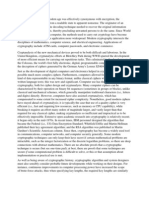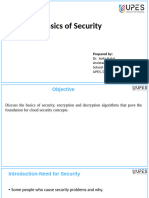Q1: Differentiate Between Conditional and Unconditional Security. Answer
Uploaded by
Raja SalmanQ1: Differentiate Between Conditional and Unconditional Security. Answer
Uploaded by
Raja SalmanQUIZ
Name: Muhammad Arslan
18-arid-2792
BSIT 5-B Morning
Q1: Differentiate between conditional and unconditional security.
Answer:
A cipher is “computationally secure” if the amount of computing power required to break the
encryption is so large that no one - not even the governments of the world, can muster enough
compute power to break it. In a lesser sense, it can also be applied to ciphers for which the compute
power necessary to break it exists, but would be prohibitively expensive to use except for 0.001% of
cases.
A cipher that is unconditionally secure is one that is provably immune to compute power and to any
form of attack. The only such cipher I know of that qualifies is the One Time Pad (OTP).
To see how OTP works, imagine having a set of identical wheels, around which all of the keyboard
characters are arranged - say there are 80 characters on each wheel. By placing the wheels on a
single spindle, and rotating each wheel so that a specific character appears at the top of the wheel,
you could “spell out” any message that you could ever type on a keyboard.
Q2: Explain Kerckhoffs' Principle.
Answer:
Kerckhoffs's principle is one of the basic principles of modern cryptography. It was
formulated in the end of the nineteenth century by Dutch cryptographer Auguste Kerckhoffs.
The principle goes as follows: A cryptographic system should be secure even if everything
about the system, except the key, is public knowledge.
Kerckhoffs's research publications
Kerckhoffs’s best known publications are two journal articles published in 1883 in the French
"Le Journal des Sciences Militaires" under the common title "La Cryptographie Militaire"
(Military cryptography). The articles covered the solutions of military cryptography that were
most up-to-date at that time. They gave a practical, experience-based approach, including six
design principles for military ciphers:
The system must be practically, if not mathematically, indecipherable.
It must not be required to be secret, and it must be able to fall into the hands of the enemy
without inconvenience.
Its key must be communicable and retainable without the help of written notes, and
changeable or modifiable at the will of the correspondents.
It must be applicable to telegraphic correspondence.
Apparatus and documents must be portable, and its usage and function must not require the
concourse of several people.
Finally, it is necessary, given the circumstances that command its application, that the system
be easy to use, requiring neither mental strain nor the knowledge of a long series of rules to
observe.
The second axiom is currently known as Kerckhoffs's principle.
Kerckhoffs's principle today
Kerckhoffs's principle is applied in virtually all contemporary encryption algorithms (DES,
AES, etc.). These algorithms are considered to be secure and thoroughly investigated. The
security of the encrypted message depends solely on the security of the secret encryption key
(its quality).
Keeping algorithms secret may act as a significant barrier to cryptanalysis, but only if such
algorithms are used in a strictly limited circle, which protects the algorithm from being
revealed. Most government ciphers are kept secret. Commercial encryption algorithms,
released to the market, have mostly been broken quite swiftly.
Kerckhoffs's principle was reformulated (perhaps independently) by Claude Shannon as "The enemy
knows the system". In that form it is called Shannon's maxim.
Q3: Explain Monoalphabetic ciphers with an example.
Answer:
A monoalphabetic substitution cipher, also known as a simple substitution cipher, relies on a
fixed replacement structure. That is, the substitution is fixed for each letter of the alphabet.
Thus, if "a" is encrypted to "R", then every time we see the letter "a" in the plaintext, we
replace it with the letter "R" in the ciphertext.
A simple example is where each letter is encrypted as the next letter in the alphabet: "a
simple message" becomes "B TJNQMF NFTTBHF". In general, when performing a simple
substitution manually, it is easiest to generate the ciphertext alphabet first, and encrypt by
comparing this to the plaintext alphabet. The table below shows how one might choose to,
and we will, lay them out for this example.
The ciphertext alphabet for the cipher where you replace each letter by the next letter in the
alphabet
There are many different monoalphabetic substitution ciphers, in fact infinitely many, as each
letter can be encrypted to any symbol, not just another letter.
The history of simple substitution ciphers can be traced back to the very earliest
civisilisations, and for a long time they were more than adequate for the purposes for which
they were needed. By today's standards they are very weak, and incredibly easy to break, but
they were a very important step in developing cryptography.
Q4: Write down the steps of key management life cycle.
Answer:
The task of key management is the complete set of operations necessary to create, maintain,
protect, and control the use of cryptographic keys. Keys have a life cycle; they’re “born,” live
useful lives, and are retired. The typical encryption key lifecycle likely includes the following
phases:
Key generation
Key registration
Key storage
Key distribution and installation
Key use
Key rotation
Key backup
Key recovery
Key revocation
Key suspension
Key destruction
You might also like
- High Paying Lead Generation Affiliate Marketing Programs - BuyGoodsNo ratings yetHigh Paying Lead Generation Affiliate Marketing Programs - BuyGoods2 pages
- Topic 3 - Applied Cryptography and Secure CommunicationNo ratings yetTopic 3 - Applied Cryptography and Secure Communication118 pages
- Classical Encryption Techniques in Cryptography and Network SecurityNo ratings yetClassical Encryption Techniques in Cryptography and Network Security46 pages
- Lecture 2- Symmetric-Key-Encryption - NotesNo ratings yetLecture 2- Symmetric-Key-Encryption - Notes128 pages
- An Overview of The History of CryptologyNo ratings yetAn Overview of The History of Cryptology20 pages
- Cryptography Prior To The Modern Age Was Effectively Synonymous WithNo ratings yetCryptography Prior To The Modern Age Was Effectively Synonymous With3 pages
- 02.L2-L3-ch02 Classical Encryption TechniquesNo ratings yet02.L2-L3-ch02 Classical Encryption Techniques49 pages
- Network Security: Dr. Md. Imdadul IslamNo ratings yetNetwork Security: Dr. Md. Imdadul Islam50 pages
- FALLSEM2023-24_CSI3022_ETH_VL2023240104364_2023-08-22_Reference-Material-INo ratings yetFALLSEM2023-24_CSI3022_ETH_VL2023240104364_2023-08-22_Reference-Material-I41 pages
- 2. Authentication - Access Control CryptographyNo ratings yet2. Authentication - Access Control Cryptography69 pages
- Nomenclatura - Encyclopedia of modern Cryptography and Internet Security: From AutoCrypt and Exponential Encryption to Zero-Knowledge-Proof Keys [Paperback]From EverandNomenclatura - Encyclopedia of modern Cryptography and Internet Security: From AutoCrypt and Exponential Encryption to Zero-Knowledge-Proof Keys [Paperback]No ratings yet
- RRU5502 Description: Huawei Technologies Co., LTDNo ratings yetRRU5502 Description: Huawei Technologies Co., LTD20 pages
- Electronics and Circuit Analysis Using MATLABNo ratings yetElectronics and Circuit Analysis Using MATLAB36 pages
- A VSS Is Network System Virtualization Technology That Pools Multiple Cisco Catalyst 6500 Series Switches Into One Virtual Switch ESNo ratings yetA VSS Is Network System Virtualization Technology That Pools Multiple Cisco Catalyst 6500 Series Switches Into One Virtual Switch ES5 pages
- Mcqs On Analog Modulation (Am FM) Am Radio Limits The Upper Modulating Frequency To 5 Khz. This Results in ANo ratings yetMcqs On Analog Modulation (Am FM) Am Radio Limits The Upper Modulating Frequency To 5 Khz. This Results in A18 pages
- ATM Adaptation Layer - Wikipedia, The Free EncyclopediaNo ratings yetATM Adaptation Layer - Wikipedia, The Free Encyclopedia2 pages
- PT Activity Configure IOS Intrusion Prevention System (IPS) Using CLINo ratings yetPT Activity Configure IOS Intrusion Prevention System (IPS) Using CLI3 pages
- Broadband Installation-Lumaday, MabbayadNo ratings yetBroadband Installation-Lumaday, Mabbayad12 pages
- IEEE 802.3ad Link Aggregation (LAG) : What It Is, and What It Is NotNo ratings yetIEEE 802.3ad Link Aggregation (LAG) : What It Is, and What It Is Not13 pages
- Com - Yy.hiyo Com-Yy-Hiyo 2020 01 27 12 33No ratings yetCom - Yy.hiyo Com-Yy-Hiyo 2020 01 27 12 3368 pages
- Ethernet For Real Time Embedded Systems White Paper PDFNo ratings yetEthernet For Real Time Embedded Systems White Paper PDF5 pages
- Plano de Estudo - Ccna 200-301 - Ccie Lucas PalmaNo ratings yetPlano de Estudo - Ccna 200-301 - Ccie Lucas Palma21 pages
- Digital Signals Processing Quiz - With AnswerNo ratings yetDigital Signals Processing Quiz - With Answer7 pages
- Design of U-Shape Microstrip Patch Antenna For Wimax Applications at 2.5 GHZNo ratings yetDesign of U-Shape Microstrip Patch Antenna For Wimax Applications at 2.5 GHZ5 pages
- Milcan Adapting Cots Canbus To Military Vetronics: Colin Davies, Radstone TechnologyNo ratings yetMilcan Adapting Cots Canbus To Military Vetronics: Colin Davies, Radstone Technology9 pages

























































































